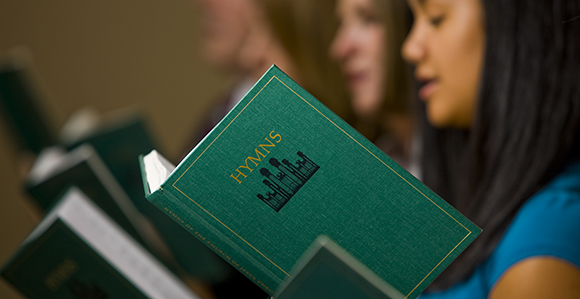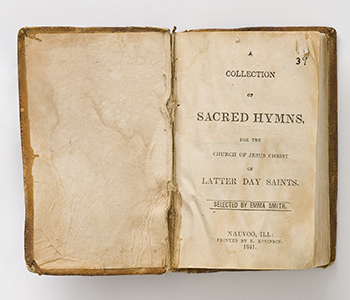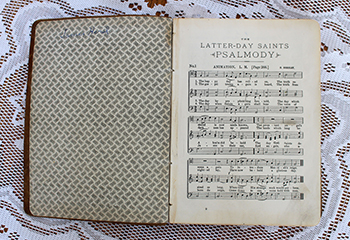How the Current Hymnbook Came to Be
Contributed By Marianne Holman Prescott, Church News Staff writer

The current version of the LDS hymnbook was published in 1985. Multiple versions came before, and the Church recently announced that a new revision will be coming in a few years.
Article Highlights
- The hymns were gathered to strengthen, encourage, and instruct the Saints.
- The original 1835 edition had 90 hymns.
- The Church recently announced a revision to the current hymnbook.
“Some of the greatest sermons are preached by the singing of hymns.” —First Presidency Preface, Hymns
Related Links
Just three months after the Church was officially organized, in a revelation to Joseph Smith in July 1830, the Lord directed the Prophet’s wife, Emma Hale Smith, to compile a hymnbook.
“And it shall be given thee, also, to make a selection of sacred hymns, as it shall be given thee, which is pleasing unto me, to be had in my church.
“For my soul delighteth in the song of the heart; yea, the song of the righteous is a prayer unto me, and it shall be answered with a blessing upon their heads” (Doctrine and Covenants 25:11–12).

A Collection of Sacred Hymns for the Church of the Latter Day Saints was published in 1835. It was compiled by Emma Smith, who received a revelation from the Lord instructing her to “make a selection of sacred hymns.”
At the time, members of the Church had been experiencing persecution as mobs interrupted meetings and threatened to harm Church members. In addition, the Prophet Joseph Smith’s life was often in danger.
It was during this time that the Prophet received revelations to strengthen, encourage, and instruct the Saints. One of the ways to do this was through music.
Although the first hymnal was not published for five years after the revelation, Emma fulfilled her assignment from the Lord. Her hymnbook, titled A Collection of Sacred Hymns for the Church of the Latter Day Saints, appeared in print in August 1835.

Latter-day Psalmody was compiled in 1889 and was the first hymnbook to include both text and music for the hymns.
The edition measured approximately three inches by four-and-a-half inches and included 90 hymn texts. Of the bunch, 39 of the hymns were written by Latter-day Saint poets, including Eliza R. Snow and Parley P. Pratt.
“As Emma Smith began to gather a hymn collection for the new Church, two influences were significant for her. On the one hand, she had a lifetime of experience with the beloved folk hymns, revival songs, and traditional Protestant anthems of her New England religious background.
“On the other hand, she felt the need for a hymn tradition that would reflect the unique history and theology of the Latter-day Saints. As heirs of divinely restored truth, the early saints wanted to do more than just borrow from other Christian hymn traditions” (Church News, Aug. 11, 1985).
Since that time, hymns have continued to be a source of strength, comfort, and worship to Church members.
“Inspirational music is an essential part of our church meetings,” it reads in the First Presidency Preface of the 1985 edition of the hymnal. “The hymns invite the Spirit of the Lord, create a feeling of reverence, unify us as members, and provide a way for us to offer praises to the Lord.
“Some of the greatest sermons are preached by the singing of hymns. Hymns move us to repentance and good works, build testimony and faith, comfort the weary, console the mourning, and inspire us to endure to the end.”
Different collections have been compiled over the years. In 1889, the Latter-day Psalmody was compiled, making it the first hymnbook to include both the text of the hymn and music. Another compilation published in 1908, Songs of Zion, included 100 gospel hymns.
More than 150 years after Emma Smith compiled the first hymnal, in 1985 the Church published the most current hymnbook, Hymns. It has 341 hymns and is available in nearly 40 languages.
“We are pleased to present this revision,” it says in the First Presidency Preface of the 1985 edition. “Many hymns found in our original hymnbook and in subsequent editions are included, as are a number of newly added hymns. All have been selected to meet the varied needs of today’s worldwide Church membership.”
Recently, the Church announced plans to revise the current hymnbook, again to meet the varied needs of today’s worldwide Church membership.
Although changes will occur, the hymnal will continue to fulfill its purpose—the same directive Emma Smith received from the Lord when she first compiled a hymnbook. That purpose is to comfort, strengthen, and inspire Church members around the globe.
“We hope to see an increase of hymn singing in our congregations,” it reads in the First Presidency Preface of the 1985 hymnal. “We encourage all members, whether musically inclined or not, to join with us in singing the hymns. We hope leaders, teachers, and members who are called upon to speak will turn often to the hymnbook to find sermons presented powerfully and beautifully in verse.”
